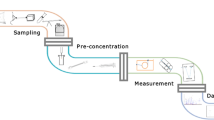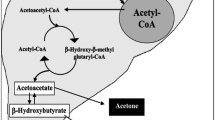Abstract
Heart failure (HF) is a clinical condition that presents high morbidity and mortality and is one of the main reasons for hospital admissions all over the world. Although biochemical processes that occur in the body during heart failure are known, this syndrome is still associated to poor prognosis. Exhaled breath analysis has emerged as a promising noninvasive tool in different clinical conditions and, recently, it has been also tested in patients with HF. This review presents the main breath HF biomarkers, which reflect metabolic changes that occur in this complex syndrome. It also discusses the diagnostic and prognostic value of exhaled breath compounds for HF and makes a short description of the main technologies involved in this analysis. Some perspectives on the area are presented as well.

Similar content being viewed by others
References
Bocchi EA, Guimarães G, Tarasoutshi F, Spina G, Mangini S, Bacal F. Cardiomyopathy, adult valve disease and heart failure in South America. Heart. 2009;95(3):181–9.
Bocchi EA, Cruz F, Guimarães G, et al. Long-term prospective, randomized, controlled study using repetitive education at six-month intervals and monitoring for adherence in heart failure outpatients: the REMADHE trial. Circ Heart Fail. 2008;1(2):115–24.
Dieplinger B, Gegenhuber A, Kaar G, Poelz W, Haltmayer M, Mueller T. Prognostic value of established and novel biomarkers in patients with shortness of breath attending and emergency department. Clin Biochem. 2010;43(9):714–9.
Morrow DA, de Lemos JA. Benchmarks for the assessment of novel cardiovascular biomarkers. Circulation. 2007;115:949–52.
Righettoni M, Tricoli A, Pratsinis SE. Si:WO(3) sensors for highly selective detection of acetone for easy diagnosis of diabetes by breath analysis. Anal Chem. 2010;82(9):3581–7.
Horowitz S. The olfactory sense and its clinical applications. Focus Altern Complement Ther. 2014;20(3):130–5.
Pereira J, Porto-Figueira P, Cavaco C, Taunk K, Rapole S, Dhakne R, et al. Breath analysis as a potential and non-invasive frontier in disease diagnosis: an overview. Metabolites. 2015;5(1):3–55.
Phillips M, Herrera J, Krishnan S, Zain M, Greenberg J, Cataneo RN. Variation in volatile organic compounds in the breath of normal. J Chromatogr B Biomed Sci Appl. 1999;729(1–2):75–88.
van den Velde S, Quirynen M, van Hee P, van Steenberghe D. Differences between alveolar air and mouth air. Anal Chem. 2007;79:3425–9.
Di Natale C, Paolesse R, Martinelli E, Capuano R. Solid-state gas sensors for breath analysis: a review. Anal Chim Acta. 2014;824:1–7.
Wilson a, Baietto M. Applications and advances in electronic-nose technologies. Sensors. 2009;9(7):5099–148.
Kupari M, Lommi J, Ventilä M, Karjalainen U. Breath acetone in congestive heart failure. Am J Cardiol. 1995;76(14):1076–8.
Maisel AS, Krishnaswamy P, Nowak RM, et al. Breathing not properly multinational study investigators. Rapid measurement of B-type natriuretic peptide in the emergency diagnosis of heart failure. N Engl J Med. 2002;347(3):161–7.
Yokokawa T, Sugano Y, Shimouchi A, Shibata A, Nakayama T, Ohara T, et al. A case of acute decompensated heart failure evaluated by series of exhaled acetone concentrations as noninvasive biomarker of heart failure severity. Int J Cardiol. 2016;204:112–3.
Neubauer S. The failing heart—an engine out of fuel. N Engl J Med. 2007;356(11):1140–51.
Stanley WC, Recchia FA, Lopaschuk GD. Myocardial substrate metabolism in the normal and failing heart. Physiol Rev. 2005;85(3):1093–129.
Lommi J, Kupari M, Koskinen P, et al. Blood ketone bodies in congestive heart failure. J Am Coll Cardiol. 1996;28(3):665–72.
Musa-Veloso K, Likhodii SS, Rarama E, et al. Breath acetone predicts plasma ketone bodies in children with epilepsy on a ketogenic diet. Nutrition. 2006;22(1):1–8.
Lommi J, Koskinen P, Näveri H, Härkönen M, Kupari M. Heart failure ketosis. J Intern Med. 1997;242(3):231–8.
Lommi J, Kupari M, Yki-Järvinen H. Free fatty acid kinetics and oxidation in congestive heart failure. Am J Cardiol. 1998;81(1):45–50.
Lopes-Cardozo M, Mulder I, van Vugt F, et al. Aspects of ketogenesis: control and mechanism of ketone-body formation in isolated rat-liver mitochondria. Mol Cell Biochem. 1975;9(3):155–73.
Lopaschuk GD, Ussher JR, Folmes CD, Jaswal JS, Stanley WC. Myocardial fatty acid metabolism in health and disease. Physiol Rev. 2010;90(1):207–58.
Sobotka PA, Brottman MD, Weitz Z, Birnbaum AJ, Skosey JL, Zarling EJ. Elevated breath pentane in heart failure reduced by free radical scavenger. Free Radic Biol Med. 1993;14(6):643–7.
Samara MA, Tang WHW, Cikach F, Gul Z, Tranchito L, Paschke KM, et al. Single exhaled breath metabolomics analysis identifies unique breathprint in patients with acute decompensated heart failure. J Am Coll Cardiol. 2013;61(13):1463–4.
McMurray J, McLay J, Chopra M, Bridges A, Belch JJF. Evidence for enhanced free radical activity in chronic congestive heart failure secondary to coronary artery disease. Am J Cardiol. 1990;65(18):1261–2.
McGrath LT, Patrick R, Silke B. Breath isoprene in patients with heart failure. Eur J Heart Fail. 2001;3(4):423–7.
Agostoni P, Bussotti M. Exhaled nitric oxide and exercise performance in heart failure. Arch Physiol Biochem. 2003;111:293–6.
Lovell SL, Stevenson H, Young IS, McDowell G, McEneaney D, Riley MS, et al. Exhaled nitric oxide during incremental and constant workload exercise in chronic cardiac failure. Eur J Clin Invest. 2000;30:181–7.
Schuster A, Thakur A, Wang Z, Borowski AG, Thomas JD, Tang WH. Increased exhaled nitric oxide levels after exercise in patients with chronic systolic heart failure with pulmonar venous hypertension. J Card Fail. 2012;18(10):799–803.
Pappas LK, Giannopoulos G, Loukides S, Gavrielatos G, Athanasopoulou E, Alexanian IP, et al. Exhaled breath condensate in acute and chronic heart failure: new insights into the role of lung injury and barrier dysfunction. Am J Resp Crit Care Med. 2014;190(3):342–5.
Pappas L, Filippatos G. Pulmonary congestion in acute heart failure: from hemodynamics to lung injury and barrier dysfunction. Rev Esp Cardiol. 2011;64:735–8.
Bykova A, Malinovskaya LK, Kuznetsova M, Chomahidze PS, Kopylov PY, Betelin VB, et al. Exhaled breath analysis in diagnostic of heart failure. Eur J Heart Fail. 2015;17:218–9.
Witt K, Fischer C, Reulecke S, Kechagias V, Surber R, Figulla HR, et al. Electronic nose detects heart failure from exhaled breath. Biomed Eng-Biomed Tech. 2013;58:Suppl 1.
Author information
Authors and Affiliations
Corresponding author
Ethics declarations
Conflict of Interest
Fabiana G. Marcondes-Braga, Guilherme Lopes Batista, Fernando Bacal, and Ivano Gutz have an issued patent (US, 8,747,325 B2) with the United States Patent and Trademark Office (USPTO) and a pending patent (PCT/BR2011/000227) with Patent Cooperation Treat (PCT).
Human and Animal Rights and Informed Consent
This article does not contain any studies with human or animal subjects performed by any of the authors.
Additional information
This article is part of the Topical Collection on Biomarkers of Heart Failure
Rights and permissions
About this article
Cite this article
Marcondes-Braga, F.G., Batista, G.L., Bacal, F. et al. Exhaled Breath Analysis in Heart Failure. Curr Heart Fail Rep 13, 166–171 (2016). https://doi.org/10.1007/s11897-016-0294-8
Published:
Issue Date:
DOI: https://doi.org/10.1007/s11897-016-0294-8




